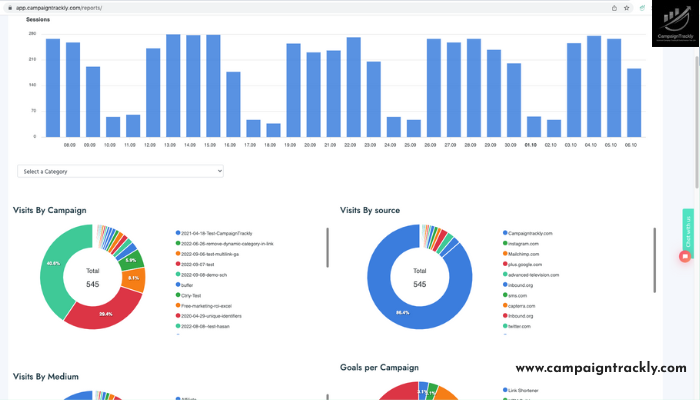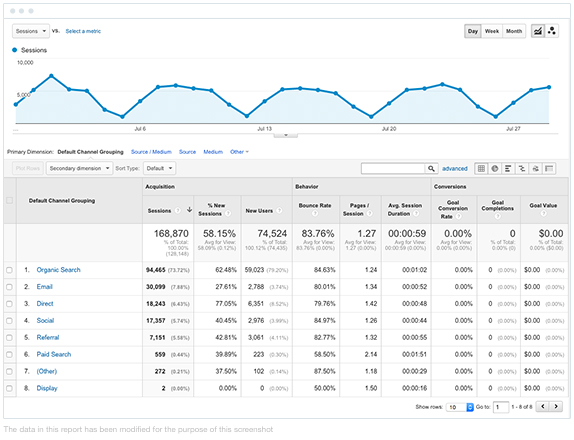Uncover the secrets behind optimizing your marketing efforts with UTM tracking codes and unlocking the power of Google Analytics.

Image courtesy of via DALL-E 3
Table of Contents
- Introduction to UTM Tracking Codes
- Setting Up Google Analytics
- Understanding UTM Parameters
- Creating UTM Codes
- Adding UTM Codes to URLs
- Tracking Campaign Performance With Google Analytics
- Common Mistakes and Troubleshooting
- Best Practices for Using UTM Codes
- Conclusion
- Frequently Asked Questions (FAQs)
Introduction to UTM Tracking Codes
Have you ever wondered how websites track where their visitors come from or which online campaigns are working the best? That’s where UTM tracking codes come into play! In this section, we’ll explore what UTM codes are and why they are essential for online businesses, with a special focus on how Google Analytics utilizes these codes to track various online campaigns.
What are UTM Codes?
UTM codes might sound complex, but they are actually quite simple. Think of UTM codes as tiny pieces of text added to the end of a URL. These codes help businesses track the source of their web traffic and understand which marketing efforts are driving the most visitors to their website. It’s like putting a tag on each link to see where it leads from.
Why Use UTM Codes?
Using UTM codes offers a host of benefits for businesses. By adding these codes to your URLs, you can pinpoint exactly where your website visitors are coming from, whether it’s from a social media post, an email campaign, or a paid advertisement. This information is invaluable for understanding the effectiveness of your marketing strategies and making informed decisions about where to invest your resources.
Setting Up Google Analytics
Setting up Google Analytics is essential for tracking the performance of your online campaigns. With Google Analytics, you can easily monitor the traffic coming to your website and analyze the effectiveness of your marketing efforts. Here’s a simple guide to help you get started with setting up Google Analytics.
Creating a Google Analytics Account
To begin, you need to create a Google Analytics account. Visit the Google Analytics website and follow the steps to set up your account. You will need to provide some basic information about your website, such as the URL and name.
Connecting Your Website
After creating your account, you will be given a tracking code that needs to be added to your website. Copy and paste this tracking code into the header section of your website’s code. This code allows Google Analytics to track the data from your website and provide you with valuable insights.
Understanding UTM Parameters
When it comes to tracking online campaigns and analyzing web traffic, UTM parameters play a crucial role. Understanding what these parameters are and how they work is essential for effectively utilizing tools like Google Analytics. Let’s break down the main components of UTM parameters and what they signify.
Image courtesy of www.campaigntrackly.com via Google Images
UTM Source
The ‘UTM source’ parameter in a URL indicates where the traffic is coming from. For example, if the source is ‘facebook’, it means the visitor clicked on a link shared on Facebook. Other examples could include ‘newsletter’ for traffic from email newsletters or ‘google’ for traffic from Google search results.
UTM Medium
The ‘UTM medium’ parameter identifies the medium through which the traffic is coming. It could be ’email’ for email campaigns, ‘CPC’ for cost-per-click advertising, or ‘social’ for social media platforms. This parameter helps you understand which channels are driving the most traffic to your website.
UTM Campaign
The ‘UTM campaign’ parameter is used to name the specific marketing campaign that the URL is associated with. By assigning a unique campaign name to each set of UTM parameters, you can easily track the performance of individual campaigns and compare their effectiveness.
UTM Content
‘UTM content’ is used to differentiate between different links within the same campaign. For example, if you have multiple ads running under the same campaign, you can use ‘UTM content’ to distinguish between them and see which one is generating the most traffic or conversions.
UTM Term
The ‘UTM term’ parameter is typically used for paid search keywords. If you are running a Google Ads campaign, for instance, you can use this parameter to track which keywords are leading to clicks and conversions on your website. It helps you analyze the effectiveness of your keyword targeting strategies.
Creating UTM Codes
UTM codes are essential for tracking web traffic and understanding the effectiveness of your online campaigns. By adding these little pieces of text to your URLs, you can easily monitor where your visitors are coming from and which marketing strategies are driving the most traffic.
Using Google’s URL Builder
To create UTM codes, you can use Google’s URL Builder tool. Simply input your website URL, along with details such as the source, medium, campaign, content, and term, and the tool will generate a unique URL with UTM parameters. This customized URL can then be used in your campaigns to track their performance.
Other UTM Code Generators
If you’re looking for alternative options, there are several free UTM code generator tools available online. These tools can simplify the process of creating UTM parameters and ensure that your tracking data is accurately captured. Some popular UTM code generators include Campaign URL Builder, UTMs.io, and UTM.io.
By utilizing these tools, you can effortlessly create UTM codes for your campaigns and gain valuable insights into your web traffic sources and campaign performances.
Adding UTM Codes to URLs
When it comes to tracking the success of your online campaigns, adding UTM codes to URLs is a vital step. These codes help you understand where your web traffic is coming from and which campaigns are performing best. Let’s explore how you can correctly add UTM codes to your URLs to effectively track your marketing efforts.

Image courtesy of medium.com via Google Images
Manual Addition of UTM Codes
To manually add UTM codes to your URLs, follow these simple steps. First, identify the URL you want to track, such as a link to your website or a specific landing page. Next, add a question mark (?) to the end of the URL, followed by the UTM parameters.
For example, if you want to track a link shared on Facebook for your summer sale campaign, your URL with UTM codes could look like this:
www.yourwebsite.com/summer-sale?utm_source=facebook&utm_medium=social&utm_campaign=summer_sale
Make sure to replace the values after the equals sign (=) with the appropriate source, medium, and campaign names for your specific marketing efforts. Once you’ve added the UTM codes, you can use this modified URL in your campaigns to track their performance in Google Analytics.
Automated Methods
If you’re managing numerous campaigns and URLs, using automated methods to add UTM codes can save you time and effort. One way to automate this process is by using programming scripts or tools that can automatically add UTM parameters to your URLs.
These tools often allow you to input the necessary information, such as the source, medium, and campaign details, and generate a URL with UTM codes ready to use in your marketing materials. By automating the UTM code generation process, you can ensure consistency and accuracy across all your tracking links.
Tracking Campaign Performance With Google Analytics
In order to monitor the effectiveness of your marketing campaigns and understand where your website traffic is coming from, utilizing UTM tracking codes in Google Analytics is essential. By analyzing the data collected through these codes, you can make informed decisions to optimize your campaigns and maximize your results.
Accessing Campaign Reports
To track your campaigns in Google Analytics, start by navigating to the ‘Acquisition’ tab in the left-hand menu. From there, click on ‘Campaigns’ and then ‘All Campaigns’. This will display a list of all your campaigns along with the associated UTM parameters.
You can further customize your reports by adding segments, comparing data, or setting specific date ranges to analyze the performance of individual campaigns or overall trends. By drilling down into the data, you can gain valuable insights into which campaigns are driving the most traffic and conversions.
Interpreting Data
When analyzing your campaign performance in Google Analytics, it’s important to understand the key metrics provided. Some of the main metrics you should pay attention to include:
- Sessions: The number of visits to your site sparked by a particular campaign.
- Goal Completions: The number of times a user completes a specific action on your site, such as making a purchase or signing up for a newsletter.
- Conversion Rate: The percentage of visitors who complete a desired goal after clicking on your campaign.
By monitoring these metrics over time, you can identify trends, measure the success of different campaigns, and adjust your marketing strategies accordingly to achieve better results.
Common Mistakes and Troubleshooting
One common mistake that can occur when using UTM codes is making typos. These tiny errors in the UTM parameters can lead to tracking issues and inaccurate data. To avoid this, double-check your UTM codes before implementing them. Make sure there are no spaces, misspellings, or incorrect characters in the codes.

Image courtesy of www.campaigntrackly.com via Google Images
Not Using Consistent Naming Conventions
Another mistake to watch out for is not using consistent naming conventions for your UTM parameters. It is essential to establish a standard naming format for your UTM source, medium, campaign, content, and term to ensure uniformity across all your campaigns. This consistency will help you easily analyze and compare the performance of different marketing efforts.
Debugging Tracking Issues
If you encounter tracking issues with your UTM codes, there are steps you can take to debug and resolve the problem. One way to troubleshoot is to check if the UTM parameters are correctly added to your URLs. Ensure that the codes are properly formatted and match the parameters set in Google Analytics.
If the tracking issue persists, you may need to review your website’s code to ensure that the Google Analytics tracking script is properly installed and functioning. Additionally, verifying that your Google Analytics account is set up correctly and linked to your website can help pinpoint any potential issues causing tracking discrepancies.
Best Practices for Using UTM Codes
When using UTM codes, it’s essential to keep things simple and easy to understand. Stick to basic terms for UTM parameters like source, medium, campaign, content, and term. By using clear and straightforward language, you can ensure accurate tracking and analysis of your campaigns.
Use a Consistent Format
Consistency is key when it comes to using UTM codes. Make sure to establish a standard naming convention across all your campaigns. Whether it’s using lowercase letters, avoiding special characters, or following a specific structure, maintaining consistency will help you organize and compare data effectively.
Regularly Review Data
To make the most of UTM tracking, it’s essential to regularly review the data in Google Analytics. By monitoring campaign performance, you can identify trends, evaluate the effectiveness of your marketing efforts, and make informed decisions based on real-time data. Regularly checking your analytics will ensure that your tracking is accurate and up-to-date.
Conclusion
In conclusion, UTM codes play a crucial role in tracking the performance of online campaigns through platforms like Google Analytics. By adding these little text snippets to URLs, marketers can gain valuable insights into where their web traffic is coming from and which campaigns are yielding the best results.

Image courtesy of www.campaignmonitor.com via Google Images
Recap of UTM Codes
UTM codes, short for Urchin Tracking Module codes, help marketers track the effectiveness of their online marketing efforts. These codes consist of parameters like source, medium, campaign, content, and term, which provide detailed information on the origin of website traffic.
Final Tips
To make the most out of UTM tracking codes, remember to keep your parameters simple and clear, maintain a consistent naming convention across all your campaigns, and regularly review your Google Analytics data to ensure accurate tracking. By following these best practices, you can optimize your marketing strategies and maximize your campaign performance.
Want to turn these SEO insights into real results? Seorocket is an all-in-one AI SEO solution that uses the power of AI to analyze your competition and craft high-ranking content.
Seorocket offers a suite of powerful tools, including a Keyword Researcher to find the most profitable keywords, an AI Writer to generate unique and Google-friendly content, and an Automatic Publisher to schedule and publish your content directly to your website. Plus, you’ll get real-time performance tracking so you can see exactly what’s working and make adjustments as needed.
Stop just reading about SEO – take action with Seorocket and skyrocket your search rankings today. Sign up for a free trial and see the difference Seorocket can make for your website!
Frequently Asked Questions (FAQs)
What happens if I don’t use UTM codes?
If you choose not to use UTM codes for tracking your online campaigns, you might miss out on crucial information about where your web traffic is coming from. UTM codes help you understand which sources, mediums, and campaigns are driving the most traffic to your website. Without this data, you may not be able to accurately assess the effectiveness of your marketing efforts and could potentially waste resources on underperforming campaigns.
Can I use UTM codes on social media?
Absolutely! UTM codes can be effectively utilized on social media platforms to track the performance of your social media campaigns. By adding UTM parameters to the URLs you share on social media, you can easily identify the specific posts, ads, or promotions that are driving traffic to your website. This data can help you determine which social media channels are the most effective for your business and tailor your future campaigns accordingly.
Do UTM codes affect SEO?
No, UTM codes do not directly impact a website’s SEO. UTM parameters are added to URLs solely for the purpose of tracking online campaigns in tools like Google Analytics. Search engines like Google ignore UTM parameters when crawling and indexing web pages, so they have no influence on your website’s organic search rankings. It’s important to remember that UTM tracking codes are meant for tracking marketing efforts and do not affect the SEO performance of your website.







